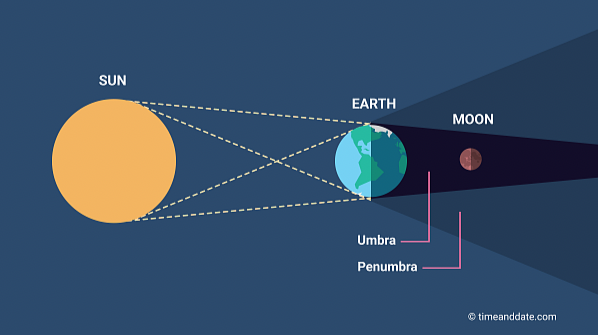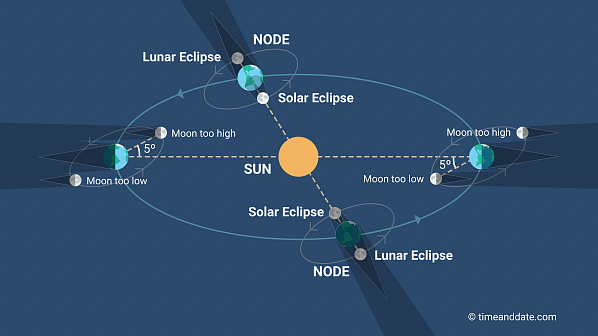Total lunar eclipse on Tuesday, November 8: All about eclipses
October 31, 2022
by Lindsey Flannery
Get ready! On November 8, 2022, a total eclipse of the moon (lunar eclipse) will be visible from North America (yes, that’s Election Day!). This will be the last total lunar eclipse for three years -- the next one doesn’t happen until March 14, 2025.1 There will continue to be partial lunar eclipses before then, but they don’t match the spectacle of a total lunar eclipse.

What’s special about a total lunar eclipse?
A total lunar eclipse always occurs on a full moon, when the sun, earth and the moon are in a straight line, and the moon goes through earth’s shadow. When the moon goes completely through the darkest part of earth’s shadow, called the umbra, we have a total lunar eclipse -- and Earth’s shadow casts a reddish hue on the moon.2 This is why a total lunar eclipse is sometimes called a “blood moon,” although it looks more like a dusty or orangish red than blood red.
A total lunar eclipse is visible from the half of Earth where it’s nighttime during the eclipse.
When do I need to watch?
You’re going to have to set your alarm especially early to witness this eclipse, although it lasts for quite a while, so you have options.
In Missouri (Central Standard Time), you’ll see Earth’s shadow begin to move over the moon at 3:09 a.m. on Tuesday, November 8. It will look like a bite is being taken out of the moon. However, totality (when Earth’s shadow fully covers the moon) doesn’t begin until 4:16 a.m.
It’s generally recommended to watch a lunar eclipse in the 15 minutes approaching totality for the best show. In Missouri, that would mean starting to watch at around 4 a.m., until the eclipse becomes full at 4:16 a.m.
However, if you’re not willing to wake up quite so early, the eclipse stays full until 5:41 a.m. So, you could see the total eclipse even if you set your alarm for 5:30 a.m.
After 5:41 a.m., the moon begins to move out of Earth’s shadow, and there will be a partial eclipse until the eclipse ends at 6:49 a.m. Toward the end, the moon will be nearly setting, so make sure you have a clear view to the west-northwest horizon, especially if you don’t plan on viewing until near the end.1
Lunar Eclipse Times on Tuesday, November 8th (Central Standard Time):
Partial Eclipse begins: 3:09 a.m.
Full Eclipse begins: 4:16 a.m.
Maximum Eclipse: 4:59 a.m.
Full Eclipse ends: 5:41 a.m.
Partial Eclipse ends: 6:49 a.m.
Why does the moon look red during a total lunar eclipse?
When the eclipse reaches totality, you can expect the moon to appear a dusty reddish hue.
While no direct sunlight is reaching the moon, Earth’s atmosphere bends sunlight and indirectly lights up the moon’s surface.3
The shorter-wavelength colors get refracted and filtered out by Earth’s atmosphere, and only the longer wavelength colors, like red and orange, make it through the atmosphere and to the moon’s surface. The more clouds or dust in Earth’s atmosphere during the eclipse, the redder the moon appears.

Why don’t we see a lunar eclipse every month at the full moon?
If a full moon is needed for a total lunar eclipse, why don’t we see one every month at the full moon?
It’s because the path of the moon’s orbit around Earth is inclined at 5° compared to the plane of Earth’s orbit around the sun (called the “ecliptic”). The moon only crosses the ecliptic twice in each of its 27 day cycles -- those intersection points are called “nodes.” For an eclipse to occur, the moon has to cross the ecliptic at the same time it is in line with the earth and sun.4
If this crossing occurs when the moon is between Earth and the sun, we see a solar eclipse (the moon blocks our view of the sun). If it occurs two weeks later when the moon is on the other side of Earth, the moon moves into Earth’s shadow, and we see a lunar eclipse. So, solar and lunar eclipses always come in pairs.
The lunar eclipse on November 8 closely follows a partial solar eclipse that occurred on the last new moon, on Tuesday, October 25, 2022. It was only visible from Europe, the Middle East and western Asia, so you likely did not witness it.
In most moon cycles, the moon crosses the ecliptic when the sun, earth and moon are not in a line (it’s not a full or new moon), so there is no eclipse.
References:
